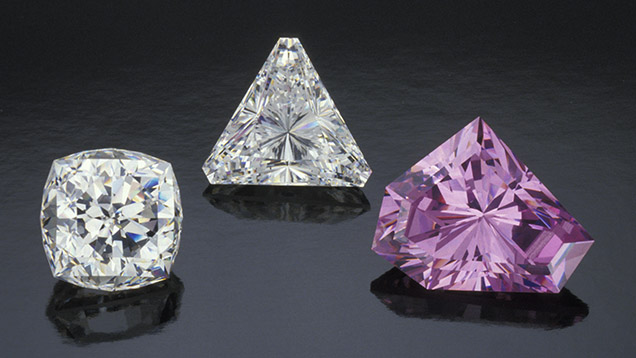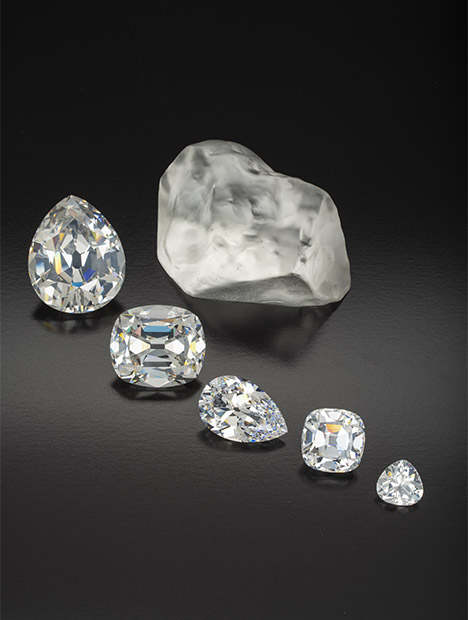
The Zing of Zircon, Part 4: The Curse of Cubic Zirconia
Share
In the history of gemstone jewellery, white zircon gemstones were long used as diamond simulants because of their striking resemblance to diamonds, with the untrained eye having virtually no way to separate the two. In fact, the terms “Matura diamond” or “Matara diamond” were once common names for the colourless variety of zircon due to their diamond-like appearance; these names make reference to a significant commercial source for these stones that was located in the Matara District of Sri Lanka’s Southern Province. The use of white zircon as a diamond simulant was particularly popular in the late 19th and early 20th Centuries when prices for diamonds sharply increased due to the influence of diamond cartels, making white zircon gems highly affordable in comparison even though they were substantially rarer in nature than diamonds. Unfortunately, this relationship between zircon and diamond gemstones began to have a negative effect on the way in which zircon was appreciated as a gemstone in its own right, as the public started to associate the name “zircon” with the concept of “imitation”. In the second half of the 20th Century, zircon gemstones would be denigrated even further by the introduction of what is now one of the world’s most common synthetic gemstones: cubic zirconia.
A round brilliant cut cubic zirconia gemstone; Image: Wikipedia
A pair of 14 karat white gold studs featuring natural “matara diamond” colourless zircon gemstones; Image; Skyjems
The term “zirconia” is another name for zirconium dioxide (ZrO2), which was originally discovered as the mineral baddeleyite in 1892, although this mineral is not analogous to “cubic zirconia” as they have different crystal structures. All crystalline materials can be organised into one of seven crystal systems based on the geometry of their internal structure. These systems are: monoclinic, triclinic, orthorhombic, tetragonal, cubic, hexagonal, and trigonal crystal systems, although the trigonal system is often grouped together with the hexagonal system as the former can be geometrically encompassed by the latter; the mineral baddeleyite falls into the monoclinic crystal system, while the aptly named cubic zirconia falls into the cubic crystal system.
Simplified diagrams of the geometries found in the six major crystal systems; Image: geology In
A large crystal of baddeleyite on matrix from Phalaborwa in Limpopo, South Africa; Image: Mindat/ Rob Lavinsky
Zirconia with a cubic crystal structure was first encountered in 1927 as a synthetic product called “stabilised zirconia”, but at first this lab-gown substance was merely a form of crystalline ceramic that had applications as a refractory material. In 1937, naturally occurring zirconia crystals with a cubic structure were discovered by German mineralogists as microscopic inclusions in samples of natural zircon (ZrSiO4) alongside inclusions of baddeleyite; the tiny inclusions were distinguished from baddeleyite with x-ray crystallography, but they were not considered significant beyond the fact that they proved synthetic cubic zirconia did have a natural counterpart, and they consequently received little attention from most scientists. Synthetic cubic zirconia did however gain traction in the scientific community as a useful material in optical research, where it eventually outpaced the use of other synthetic crystals, like yttrium aluminium garnet, gadolinium gallium garnet, synthetic rutile, and synthetic strontium titanate.
Individual crystals of cubic zirconia suitable for optical applications were difficult to grow, and production of such crystals did not accelerate until the 1960’s when melt growth techniques were heavily investigated in France, although these methods initially only yielded small crystals. Soviet scientists developed a successful technique for growing larger crystals called ”skull crucible”, which was published in 1973 and paved the way for the commercial production of cubic zirconia that began in 1976. By 1977, cubic zirconia was being mass-produced for use in the jewellery industry as a diamond simulant. Annual worldwide production of cubic zirconia gemstones had reached approximately 60 million carats by 1980, and it had grown to over 33 times that amount by 1998 following the development of the “skull-melting” method, which was patented by Josep F. Wenkus in 1997 and remains the primary technique for producing gem quality cubic zirconia to this day. The flood of synthetic cubic zirconia gems into the jewellery market has only caused further confusion among buyers surrounding natural zircon (ZrSiO4) gemstones due to strong similarities in name between these two materials, cementing the idea in many people’s minds that the term “zircon” refers to cheaper laboratory grown stones rather than natural Earth-mined gems.
As a gemstone, cubic zirconia (ZrO2) strongly resembles diamond (Cx) and zircon (ZrSiO4) gemstones due to its high dispersion value and diamond-like lustre; cubic zirconia actually has greater dispersion or “fire” than diamonds (0.058-0.066 vs. 0.044) which does give the stone an attractive appearance, but when compared to diamonds and zircon the fire of cubic zirconia is so strong that it may seem unnatural to the discerning eye. The refractive index of diamond is higher than cubic zirconia, so the latter does not show as much brilliance as the former, and cubic zirconia’s hardness is also lower than that of diamond, ranking at 8-8.5 on the Mohs Hardness Scale, whereas diamond ranks at 10 as one of the worlds hardest materials. The lower hardness of cubic zirconia gemstones causes them to be abraded more easily than diamonds and consequently need repolishing or replacement on a more frequent basis, however the hardness of zircon (Mohs 6-7.5) is even lower than cubic zirconia, a factor which contributed to cubic zirconia’s replacement of zircon in the 20th Century as the primary diamond simulant.

Colourless and pink cubic zirconia gemstones; Image; GIA/ Tino Hammid
There was an initial advantage that zircon (ZrSiO4) had over cubic zirconia (ZrO2): its colour. In the earliest days of cubic zirconia use within the jewellery industry, only natural white zircons were replaced by this synthetic material, while natural coloured zircons could still be used in ways that cubic zirconia could not. Very quickly after its introduction, cubic zirconia gemstones which displayed different hues were developed by doping growth solutions with additional metals, the same method used for producing coloured synthetic corundum, coloured synthetic spinel, and other coloured synthetic gemstones. For cubic zirconia, cerium (Ce) dopants induced orangish hues, chromium (Cr) and Vanadium (V) dopants induced green hues, nickel (Ni) and thulium (Tm) dopants induced brownish hues, erbium (Er) and europium (Eu) dopants induced pink hues, cobalt (Co) and neodymium (Nd) dopants induced purplish hues, iron (Fe) and holmium (Ho) dopants induced yellowish hues, titanium (Ti) dopants induced golden hues, copper (Cu) dopants induced yellow and bluish hues, manganese (Mn) dopants induced brown and/or violet hues, and praseodymium (Pr) dopants induced amber hues. By giving cubic zirconia (ZrO2) gemstones the ability to display a colour range as diverse as that of natural zircon (ZrSiO4), these synthetic gemstones further overshadowed zircon gems in the jewellery trade, leading to the grossly underappreciated profile of natural zircon that is prevalent today.
A series of different coloured cubic zirconia crystals; Image: GIA/ Ceres Corporation
A variety of different coloured cubic zirconia gemstones; Image: GIA/ Ceres Corporation
© Yaĝé Enigmus














